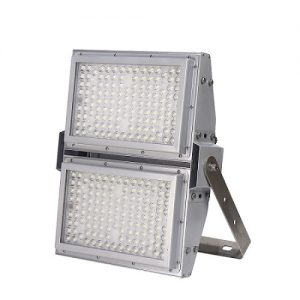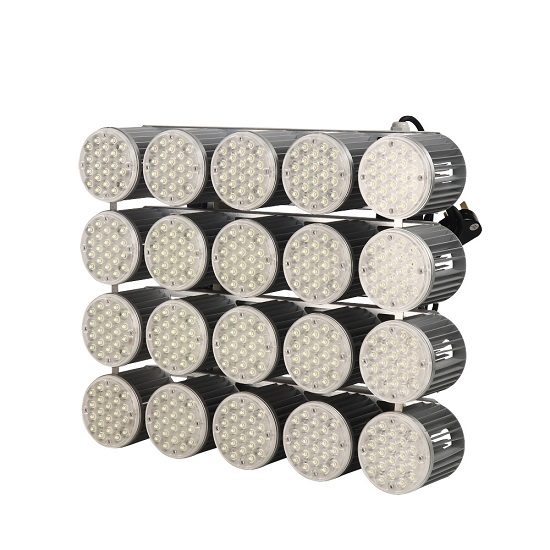The Development Status of the Global LED Industry
We usually call materials with poor or poor electrical and thermal conductivity, such as diamond, artificial crystals, amber, ceramics, etc., as insulators. And metals such as gold, silver, copper, iron, tin, aluminum, etc., which have good electrical and thermal conductivity are called conductors. You can simply call the material between the conductor and the insulator a semiconductor. Compared with conductors and insulators, the discovery of semiconductor materials is the latest. It was not until the 1930s that the existence of semiconductors was truly recognized by the academia when the purification technology of materials improved.
A substance with a resistivity between metal and insulator and a negative temperature coefficient of resistance. The resistivity of a semiconductor is about 10E-5~10E7 ohm·m at room temperature, and the resistivity index decreases when the temperature rises. There are many semiconductor materials, which can be divided into element semiconductors and compound semiconductors according to their chemical composition. The huge temptation of semiconductor lighting has made many countries optimistic about the future of the lighting field, and governments around the world have put them into practice. The U.S. Energy Department predicts that by 2030, 80% of the U.S. incandescent and fluorescent lamps will be replaced by semiconductor lighting, which will save 35 billion U.S. dollars each year. The United States has launched the National Semiconductor Lighting Project, the European Union has launched the Rainbow Project, and Japan has launched the 21st Century Light Project. The Japanese government made it clear that in 2025 it will replace traditional incandescent lamps with semiconductor lighting on a large scale.
China is the world’s largest lighting fixture manufacturer and has a huge lighting industry and lighting market. At the same time, China has overcome the technical difficulties of high-power light-emitting chips, and the industrial significance and value of semiconductor lighting are immeasurable. The National Semiconductor Lighting Project jointly implemented by the Ministry of Science and Technology and more than a dozen local governments has also started. In June 2003, China established the “National Semiconductor Lighting Engineering Leading Group”, represented by the Institute of Semiconductors and Physics of the Chinese Academy of Sciences, Peking University, Tsinghua University and other scientific research institutes, actively involved in the research and development of the third-generation semiconductor materials, and integrated technological achievements. Since the successful development of LEDs (Semiconductor Light-Emitting Diodes) by the Changchun Institute of Physics, Chinese Academy of Sciences in the late 1960s.
There have been more than 3,500 LED companies in China with more than 500,000 employees and an annual output of 400 related devices. More than 100 million, the market size has exceeded $30 billion. At present, a relatively complete industrial chain from epitaxial wafer production, chip preparation, and device packaging integration applications has been initially formed. There are more than 400 enterprises engaged in the production of semiconductor light-emitting diode devices and lighting systems across the country. China has already sold a large number of low- and medium-end LED products in the fields of display screens and traffic signals, and has formed certain application development technologies and independent intellectual property rights.
In terms of policy, the China Green Lighting International Conference and the Sixth International High-Efficiency Lighting Conference held in May this year clearly stated that during the “Fourteenth Five-Year Plan” period, the National Development and Reform Commission will focus on public facilities, hotels, commercial buildings, office buildings, sports promote high-efficiency energy-saving lighting systems in venues and residential buildings. The state will also strictly enforce market access for lighting products.
Products that do not meet the mandatory performance and efficiency standards shall not be produced and sold, and buildings that do not meet the building lighting energy-saving standards shall not be constructed. The state will establish an incentive mechanism to accelerate the promotion and application of high-efficiency lighting products, and research and propose fiscal and taxation policies that encourage the production and use of high-efficiency lighting products. Scientists predict that although semiconductor lighting replaces energy-saving lamps, it may take several years or even longer to enter China’s millions of households, ranging from landscape lighting and outdoor large screens to toys, flashlights, and Christmas lights. People have reason to believe that, LED will illuminate everyone’s room and change our lives.
Semiconductor classification and performance
(1) Elemental semiconductors. Elemental semiconductor refers to a semiconductor composed of a single element, among which silicon and selenium have been studied relatively early. It is a solid material with semiconductor characteristics composed of the same elements, which is susceptible to changes caused by trace impurities and external conditions. At present, only silicon and germanium have good performance and are widely used. Selenium is used in electronic lighting and optoelectronic fields. Silicon is widely used in the semiconductor industry, which is mainly affected by silicon dioxide, which can form a mask on the device production, can improve the stability of semiconductor devices, and is conducive to automated industrial production.
(2) Inorganic composite semiconductors. Inorganic composites are mainly composed of a single element as a semiconductor material. Of course, there are also semiconductor materials composed of multiple elements. The main semiconductor properties are Group I and Group V, VI, and VII; Group II and Group IV, V, VI, and VII; III Groups and V, VI; IV and IV, VI; V and VI; VI and VI combined compound, but affected by the characteristics of the elements and production methods, not all compounds can meet the semiconductor material Requirements. This semiconductor is mainly used in high-speed devices. Transistors made by InP are faster than other materials, and are mainly used in optoelectronic integrated circuits and anti-nuclear radiation devices. For materials with high conductivity, they are mainly used in LEDs and other aspects.
(3) Organic compound semiconductor. Organic compounds refer to compounds containing carbon bonds in their molecules. The organic compounds and carbon bonds are perpendicular to each other to form a conduction band. Through chemical addition, it can enter the energy band, which can generate electrical conductivity and form Organic compound semiconductor. Compared with previous semiconductors, this semiconductor has the characteristics of low cost, good solubility, and easy processing of light materials. The conductivity can be controlled by controlling molecules, and it has a wide range of applications, mainly used in organic thin films, organic lighting, etc.
(4) Amorphous semiconductor. It is also called amorphous semiconductor or glass semiconductor, which belongs to a class of semi-conductive materials. Amorphous semiconductors, like other amorphous materials, have short-range order and long-range disordered structures. It mainly forms amorphous silicon by changing the relative position of atoms and changing the original periodic arrangement. The crystalline state and the amorphous state are mainly different from whether the atomic arrangement has a long order. It is difficult to control the performance of amorphous semiconductors. With the invention of technology, amorphous semiconductors began to be used. This production process is simple, mainly used in engineering, has a good effect in light absorption, and is mainly used in solar cells and liquid crystal displays.
(5) Intrinsic semiconductors: semiconductors without impurities and lattice defects are called intrinsic semiconductors. At extremely low temperatures, the valence band of a semiconductor is full. After being excited by heat, some electrons in the valence band will cross the forbidden band and enter the empty band with higher energy. The electrons in the empty band become the conduction band. The absence of an electron forms a positively charged vacancy, called a hole. Hole conduction is not actual movement, but an equivalent. When electrons conduct electricity, holes of equal charge will move in the opposite direction. [5] They produce a directional movement under the action of an external electric field to form a macroscopic current, which are called electron conduction and hole conduction, respectively.
This kind of mixed conductivity formed by the generation of electron-hole pairs is called intrinsic conductivity. The electrons in the conduction band fall into holes, and the electron-hole pairs disappear, which is called recombination. The energy released during recombination becomes electromagnetic radiation (luminescence) or lattice thermal vibration energy (heating). At a certain temperature, the generation and recombination of electron-hole pairs exist at the same time and reach dynamic equilibrium. At this time, the semiconductor has a certain carrier density and thus a certain resistivity. When the temperature increases, more electron-hole pairs will be generated, the carrier density will increase, and the resistivity will decrease. The resistivity of pure semiconductors without lattice defects is relatively large, and there are not many practical applications.
Semiconductor application field
Semiconductors are used in integrated circuits, consumer electronics, communication systems, photovoltaic power generation, lighting applications, high-power power conversion and other fields.
Photovoltaic applications
The photovoltaic effect of semiconductor materials is the basic principle of solar cell operation. At this stage, the photovoltaic application of semiconductor materials has become a hot topic, and it is currently the fastest-growing and best-developing clean energy market in the world. The main manufacturing material of solar cells is semiconductor materials. The main criterion for judging the quality of solar cells is the photoelectric conversion rate. The higher the photoelectric conversion rate, the higher the working efficiency of the solar cell. According to the different semiconductor materials used, solar cells are divided into crystalline silicon solar cells, thin film cells and III-V compound cells.
Lighting application
LED is a semiconductor light-emitting diode built on a semiconductor transistor. Using LED technology, the semiconductor light source is small in size and can be packaged in a flat surface. Developed into light, thin and short products, once they came out, they quickly became popular and became a new generation of high-quality lighting sources, which have been widely used in our lives. Such as traffic lights, backlight sources of electronic products, light sources for city night beautification, indoor lighting, etc., have applications.
High-power power conversion
The mutual conversion of alternating current and direct current is very important for the use of electrical appliances, and is a necessary protection for electrical appliances. This requires a power conversion device. Silicon carbide has high breakdown voltage strength, wide band gap, and high thermal conductivity. Therefore, SiC semiconductor devices are very suitable for applications where power density and switching frequency are high. Power supply replacement devices are one of them.
Another performance of silicon carbide components in high temperature, high pressure and high frequency has made them widely used in deep well drilling, inverters in power generation devices, energy converters in electric hybrid vehicles, and light rail train traction power conversion. Due to the advantages of SiC itself and the industry’s demand for lightweight and high conversion efficiency semiconductor materials at this stage, SiC will replace Si and become the most widely used semiconductor material.
Difficulties and problems
(1) Difficulties of semiconductor refrigeration technology
Many parameters are involved in the semiconductor refrigeration process, and the conditions are complex and changeable. Any parameter will have an impact on the cooling effect. In laboratory research, because it is difficult to meet the specified noise, it is necessary to study the laboratory environment, but the discussion of some influencing factors is difficult. Semiconductor refrigeration technology is a refrigeration technology based on the particle effect and is reversible. Therefore, in the application of refrigeration technology, there will be a large temperature difference between the hot and cold ends, which will inevitably affect the refrigeration effect.
(2) Problems in semiconductor refrigeration technology
Firstly, the quality coefficient of semiconductor materials cannot be further improved as needed, which will inevitably affect the application of semiconductor refrigeration technology.
Secondly, optimize the design of the cold-end cooling system and the hot-end cooling system, but there is no technical upgrade, and it is still in the theoretical stage, and it does not play a better role in the application, which leads to the semiconductor refrigeration technology not being able to meet the application needs Be promoted.
Thirdly, semiconductor refrigeration technology has limitations for applications in other fields and related fields. Therefore, semiconductor refrigeration technology is rarely used, and the research on semiconductor refrigeration technology does not start from the perspective of application, and it is difficult to expand technically. Fourth, in the market economy environment, the development of science and technology, and the development of semiconductor refrigeration technology need to consider many aspects. Pay attention to the application of semiconductor refrigeration technology, but also consider various influencing factors to make this technology work better.







